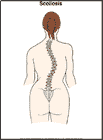
Scoliosis
What is scoliosis?
Scoliosis means that the spine curves somewhat from side to side rather than being straight down the back. The spine is made of bones called vertebrae that normally stack one on top of the other in a straight line. The bones in the upper back are called thoracic vertebrae. This is the most common site for scoliosis. The bones in the lower back are called lumbar vertebrae. Scoliosis occurs less often in the lumbar vertebrae.
Scoliosis develops gradually. Scoliosis is usually noticed just before or during puberty when your child is going through a growth spurt. Girls get scoliosis more often than boys. Usually parents do not notice the gradual changes caused by scoliosis. The curvature is usually discovered by a doctor or school nurse.
What is the cause?
There are many causes of scoliosis. Sometimes vertebrae are incompletely formed or misshapen. Sometimes children who have legs of different lengths will develop a curvature of the spine. Other times, diseases cause scoliosis. However, in children and teens the cause is most often unknown. When a cause for the scoliosis cannot be found, it is called idiopathic scoliosis.
In idiopathic scoliosis some of the vertebrae are rotated. This causes the ribs on one side of the back to stick out more, causing a hump. The muscles attaching the vertebrae to the ribs on either side may not be pulling with equal forces. This may cause one set of rib muscles to pull harder and twist the vertebrae causing them to move out of a straight line down the back.
What are the symptoms?
At first, the symptoms are painless and not always easy to recognize. Someone with scoliosis may:
- Have uneven shoulders or waist
- Have a hump on one side of the back
- Have one or both shoulder blades sticking out
- Lean slightly to one side.
Sometimes patients with scoliosis will have back pain.
How is it diagnosed?
The health care provider will take a medical history to see if there may be a cause for the scoliosis. The provider will do a physical examination and will check the back, chest, shoulders, pelvis, legs, feet and skin. The curve of the spine may be measured during the physical exam. X-rays can be taken to more precisely measure the curvature of the spine.
How is it treated?
Your provider will suggest the treatment based on your age, how much you are likely to grow, the degree and pattern of the curve and the type of scoliosis. You may be referred to a back specialist. Treatment may include:
- Observation: You will be re-examined every 4 to 6 months if you are still growing and you have a curvature of less than 20° to 25°.
- Bracing: Your provider may advise you to wear a brace if you are still growing and have a curve of 20° to 25°. The brace will help stop the curve from getting worse.
- Surgery: Doctors will usually advise surgery if a curve is greater than 45°.
Symptoms from scoliosis may be treated with physical therapy.
When can I return to my sport or activity?
Exercise will not worsen scoliosis. Sports participation will improve strength, flexibility and fitness. If you have mild to moderate scoliosis, you can participate in most levels and types of sports. If you have had surgery for your scoliosis, you should discuss the appropriate level of participation with your surgeon. If you have back pain while playing sports, talk to your health care provider.

